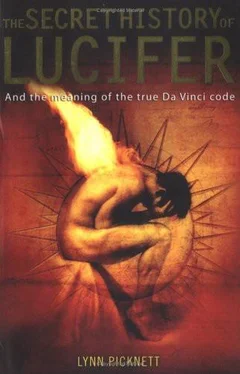There is little mystery about the nature of Chretien's graal. Although later writers seem to have been unaware of the meaning of the term, Chretien clearly felt he had no need to elaborate because he assumed his audience would be familiar with a graal. Unromantically, the word is probably a variant of the Old French gradal, meaning a type of serving dish. He describes it specifically as scutella lata et aliquantulum profunda - `a wide and slightly deep dish' - in other words, something like a platter or salver, a conclusion supported by the fact that it magically produces food (in this version only for the Fisher King, but in later versions for the whole court). Its magical or mystical properties make it important, not the fact that it is a grail. (Just as the significance of a story about a magic teapot would lie in the fact that it was magic, not that it was a teapot.)
Chretien's tale was both popular and unfinished, presenting an irresistible challenge to other poets to compose their own versions, so the story - and the Grail - underwent a rapid process of evolution. The focus shifted away from Perceval, the hero of the Grail quest becoming Gawain (probably because Chretien's story breaks off in the middle of a subplot in which he features) and then Galahad, a newly invented, annoyingly perfect character who basically seems like a thinly-disguised Jesus.
The development of the Grail into the Cup of Christ happened quickly. In an anonymous continuation of Perceval, written within a decade or so of Chretien's original, the author fused it with quite separate legends - which, according to British author Andrew Collins ,27 date back to the eighth or ninth centuries - of Joseph of Arimathea bringing a cup containing Jesus' blood to Britain. Presumably this was inspired by the concept of the Grail as a vessel, the author casting around for something similar to link it with Jesus.
This line was followed by Robert de Boron in Joseph d'Arimathie, written in the 1190s or very early 1200s. This is when it becomes the Holy Grail - sangreal: Robert was aware of the pun of `San greal' and `Sang real' '21 although in his version the latter meant `true blood'. A major, influential telling of this version of the Grail story was the Queste del San Graal, part of a vast Arthurian cycle composed by Cistercian monks between 1215 and 1235 (in which Galahad makes his first appearance).
Clearly all this represents the Christianization of the Grail, and the development of the Grail story into a Christian morality tale. Whether this was a deliberate attempt to undermine the heretical elements of the original, or simply the result of the permeation of Christian thought throughout all medieval art and literature, is impossible to tell. (The legends of Joseph of Arimathea were not entirely devoid of the whiff of heresy, since the legend also claimed that Joseph carried secret teachings of Jesus, which he passed on to his family. Besides, the Grail quest never really lost its Gnostic flavour, with the hero finding his way to the divine through his own endeavours; but perhaps this was damage limitation by the Church.) It was this line that went on to influence Mallory's La Morte d'Arthur and even the Steven Speilberg/Harrison Ford classic, Indiana Jones and the Last Crusade.
However, this was quite different from the line taken in the other major retelling of the Grail story, Wolfram von Eschenbach's Parzival, written between 1200 and 1210, therefore in parallel with the `Christ's Cup' concept. It would be interesting to know whether Wolfram was aware of, and deliberately ignored, the Christianized continuations of Chretien's tale.
A slight ripple was created by the anonymous Perlesvaus, written between the 1190s and 1220s, as the author - a cleric of some kind - claimed that he found the story in a book at Glastonbury Abbey, though most scholars believe this was just an attempt to gain credibility. Sitting between the Christianized version and Wolfram's, it is clearly based on Robert de Boron's version of the fused Grail/Joseph of Arimathea tale and, on the surface, follows the same Christian morality tale, but it has some very interesting heretical elements - an emphasis on severed heads, alchemical references and Gawain's parallel quest for the sword that beheaded John the Baptist.
In Parzival, the Gral is described as a stone. Why Wolfram transformed Chrdtien's dish or salver in this way is unknown - it has been suggested that he simply misunderstood the French word (he made other mistakes in translation, for example rendering `carving dish' as `carving knives'). However, his Grail does have the property of miraculously producing food and drink, so there is still the connection with a serving dish. Wolfram gives the Grail many other magical abilities - those who see it cannot die for a certain length of time, and instructions from Heaven appear on it.
However, if Wolfram's reason for making the Grail a stone remains unknown, at least we know where his idea originated: the medieval German poem Alexander, itself derived from popular legends of the Emperor Alexander, many variants of which circulated in the Middle Ages. Wolfram is known to have been familiar with Alexander and several elements of Parzival are clearly inspired by it. Most importantly, Alexander receives a miraculous stone - it changes weight and in some versions has rejuvenating properties - which is even described in some Latin copies as lapis exilis ('small stone'), which presumably became corrupted into Wolfram's term for the Grail, lapsit exillis. So Wolfram, too, has merged Chretien's Grail story with a separate legend.
Wolfram links the origins of the Grail - its being brought to earth - with the `neutral angels', i.e. those who took neither side in the war between God and Lucifer, although there is some ambiguity about whether the neutral angels or another group were responsible for bringing it down to earth (see below). In any case, since the angels departed it has been protected by an order of knighthood, explicitly described as Templars, and a bloodline of Grail kings.
Wolfram claimed not only to know the proper ending to the story, but also to have had access to a more authentic version than even Chretien - although if Chretien based his story on Peredur, then this claim is clearly false. Wolfram states that his version derived from the works of the `heathen' Flegetanis, via Kyot of Provens:
There was a heathen named Flegetanis who was highly renowned for his acquirements. This same physicus was descended from Solomon, begotten of Israelitish kin all the way down from ancient times till the Baptism became our shield against hellfire. He wrote of the marvels of the Gral. Flegetanis, who worshipped a calf as though it were his god, was a heathen by his father. How can the Devil make such mock of such knowledgeable people, in that He Whose power is greatest and to Whom all marvels are known neither does nor did not part them from their folly? For the infidel Flegetanis was able to define for us the recession of each planet and its return, and how long each revolves in its orbit before it stands at its mark again. All human kind are affected by the revolutions of the planets. With his own eyes the heathen Flegetanis saw - and he spoke of it reverentially - hidden secrets in the constellations. He declared there was a thing called the Gral, whose name he read in the stars without more ado. `A troop left it on earth and then rose high above the stars, if their innocence drew them back again. Afterwards a Christian progeny bred to a pure life had the duty of keeping it. Those humans who are summoned to the Gral are ever worthy.' Thus did Flegetanis write on this theme.
The wise Master Kyot embarked on a search for this tale in Latin books in order to discover where there may have been a people suited to keep the Gral and follow a disciplined life. He read the chronicles of various lands in Britain and elsewhere, in France and Ireland; but it was in Anjou that he found the tale 29
Читать дальше












